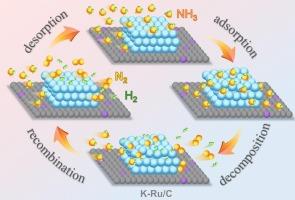负载钌的碳基催化剂上氨分解的雾化钾辅助制氢
IF 13.2
1区 工程技术
Q1 ENGINEERING, CHEMICAL
引用次数: 0
摘要
催化氨分解高效制氢对氢能在多种应用领域的发展具有重要意义。本文报道了一种通过雾化钾修饰钌负载碳材料(K-Ru/C)进行表面重构的策略,以促进氨分解过程中氮再活化的速率决定步骤。K-Ru/C在高质量时空速为30,000 mL·gcat−1·h−1时的NH3转化率为96.7 %,在500 ℃时的H2生成速率为32.4 mmol·gcat−1·min−1,远远优于Ru/C,这得益于原子K修饰引起的碱性位点的增加和反应动力学的改善。此外,在550 °C连续反应150 h后,Ru纳米颗粒的活性保持率高达98.1% %,这可以通过operando表征证明在分解过程中Ru纳米颗粒的持续转化而没有尺寸变化来验证,揭示了氨分解高效制氢在实际应用中的巨大潜力。本文章由计算机程序翻译,如有差异,请以英文原文为准。

Atomized potassium-assisted hydrogen generation from ammonia decomposition over ruthenium loaded carbon-based catalysts
Hydrogen generation from catalytic ammonia decomposition with high efficiency is significant to the evolution of hydrogen energy in diverse applications. Herein, a surface reconstruction strategy via atomized potassium decorated ruthenium loaded carbon material (K-Ru/C) is reported to facilitate the rate-determining step of nitrogen remobilization during ammonia decomposition process. Benefiting from the increased basic sites and the improved reaction kinetics induced by atomic K modification, K-Ru/C exhibits an excellent performance with a remarkable NH3 conversion efficiency of 96.7 % at a high weight hourly space velocity of 30,000 mL·gcat−1·h−1 and an encouraging H2 generation rate of 32.4 mmol·gcat−1·min−1 at 500 °C, much superior to that of Ru/C. Moreover, the high stability of 98.1 % in activity retention after 150 h consecutive reaction at 550 °C can be authenticated by the constant conversion without dimensional change of Ru nanoparticles during the decomposition process evidenced by operando characterization, revealing an enormous potential in practical application of efficient hydrogen generation from ammonia decomposition.
求助全文
通过发布文献求助,成功后即可免费获取论文全文。
去求助
来源期刊

Chemical Engineering Journal
工程技术-工程:化工
CiteScore
21.70
自引率
9.30%
发文量
6781
审稿时长
2.4 months
期刊介绍:
The Chemical Engineering Journal is an international research journal that invites contributions of original and novel fundamental research. It aims to provide an international platform for presenting original fundamental research, interpretative reviews, and discussions on new developments in chemical engineering. The journal welcomes papers that describe novel theory and its practical application, as well as those that demonstrate the transfer of techniques from other disciplines. It also welcomes reports on carefully conducted experimental work that is soundly interpreted. The main focus of the journal is on original and rigorous research results that have broad significance. The Catalysis section within the Chemical Engineering Journal focuses specifically on Experimental and Theoretical studies in the fields of heterogeneous catalysis, molecular catalysis, and biocatalysis. These studies have industrial impact on various sectors such as chemicals, energy, materials, foods, healthcare, and environmental protection.
 求助内容:
求助内容: 应助结果提醒方式:
应助结果提醒方式:


